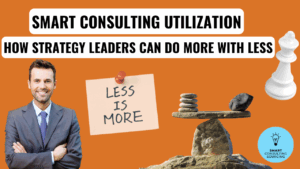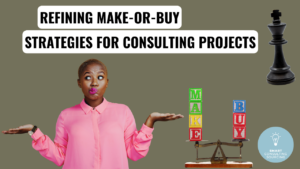In this episode, I’ll be talking about securing the impact on your consulting project.
But before we dive into today’s episode, let’s give you guys a small recap about our previous 6-Lever series episode.
We talked about setting up the right delivery model for your consulting project. The key, here, is to understand where the company stands and what the different options are out there before making a decision on what delivery model would be best suited for your project.
The first step is deciding which ones of these options make sense based on your culture, policies, and project needs. Not every option is suitable for every situation.
There are delivery models that you can choose from: it can be working with an In-house consulting team, having a hybrid team with a mix of in-house expertise and also expert consultants, or outsourcing the project to a consulting firm if necessary.
And there are also other options that you could consider is having micro-consulting (very short projects or experts on demand), or just hiring a temporary workforce from on od the many marketplaces that are available today. Then build simple tools to help your business lines to make informed decisions for their projects, in other words, lead their make-or-buy analysis. And now, it’s time to jump into today’s topic, “How to Secure the Impact on your consulting project!”
Secure the Impact of Your Consulting Project; Crucial to Ensure the Success of the Project
Are you disappointed with the results of your consulting projects and somehow feel that you could have done better? The good news is that it doesn’t have to be that way!
You can make a real difference in advancing your strategy, tracking efficiencies, or capturing savings. But for that your projects need to deliver impact right. But actually, it start before. It starts with working on the right projects and assembling the right project team (i.e. delivery model) for maximum effectiveness. And a wise man once said, the right process/ teams/ collaboration with the right people can go a long way.
If you are curious about how to invest in the right projects or setting up the right delivery model, you can head back and listen to those episodes to get the whole picture on how to maximize the ROI of your consulting spend.
So, coming back to securing the impact, well, you know this has more to do with your business lines than the procurement department, but still you’ll see that involving your procurement teams early will be beneficial.
Mastering Project Scope: Differentiating Must-Haves from Nice-to-Haves to Secure the Impact
Now that you are working on the right projects and with the right set up, you need to make sure you work on the right scope.
What I mean by this is that you need to differentiate between all the must have and nice to have requirement for the project. So, before you secure the impact on your consulting project, make sure to define your needs finely.
Take a look at what’s truly necessary before embarking on the must-haves. So, when it comes to maximizing ROI of your consulting spend, there are two sides to the problem. One side is about how to secure the impact or the value and the other one is the costs. But these are the two faces of the same coin actually,
When you invest in a big CAPEX project for instance, a new factory or new machinery, do you look only at the results? No, you want the most cost-efficient solution. Well, that should be the same for consulting.
So, define what you want to work on but how you want to work too; keep a close eye on the delivery model of your project and plan strategically. Overall, this gives you total clarity from start to finish, ensuring your goals are achievable!
Working With the Right Consulting Firm Is Essential to Secure the Impact
Now comes the part of choosing the consulting that you need! That is, if you outsource the project.
Working with the right consulting firm is essential to secure success: one that has the capability to understand your specific project, as well as experience and political weight. So for those who wonder, the political weight is the credibility of a consulting firm in the eyes of your board, or investors and it can be an important part of your choice.
Sometimes you also want a consulting firm that understands a given language and culture, not that I am saying you should go for the local consulting firm but you can choose the best consulting firm that understand the said language and culture. For instance, would you send a German consultant to rural France, where nobody speaks English or German? No. Unless the said consultant speaks French, and understands the managerial culture in SMEs in rural France. Your consultant should fit into this new space like a missing puzzle piece; something that will secure the impact on your consulting project.
Therefore, when it comes to successfully sourcing consulting services, you should aim for the right combination of expertise, industry experience and a tailored approach to secure your goals.
Your Consultants and Stakeholders Need to Be on the Same Page
After getting the basic of who, what, where and when out of the way, it’s time to get everyone aligned. What I mean by this is that; make sure that your consultants and stakeholders are on the same page before starting a project.
You don’t want one side thinking they have access to endless resources while the other is expecting something confined to a tight budget, for example. Or not agree on what should be delivered and when. Work together to ensure that you make clear expectations for deliverables, timeline, governance, etc., so there’s no ambiguity about how things will go down.
Your Project’s Impact Depends on How You Manage Your Project
Now that you’ve checked off all the boxes, and your project is ready to start, you’re half way there to secure the impact, and then it’s time for the fun part: managing it. After all the planning, strategizing, and analyzing, finally you can make a real difference! Managing a project will no doubt bring its share of ups and downs, but with the right attitude and preparation, you can make it successful – it just takes some time. So let me tell you how to manage those projects.
First things first, having a designated project manager in place can help ensure that the proper resources are allocated and allocated appropriately, while also keeping an eye on the progress being made by both the project and its consultants.
By taking the time to manage your consulting project, you can reduce delays, manage costs, gain greater control over the timeline for completion and the quality and adequacy of the deliverables. And ultimately, that’s how you maximize your return on investment.
While the project manager is there to see everything is done the way it’s supposed to, you also need to make sure that progress is made and goals are met, setting up regular project meetings can be an important aspect of successful management.
These meetings are usually weekly, so that you and your team can assess how the project is progressing, reassess goals when necessary, and provide a chance to all team members to voice any issues which would be a great way of staying on top of the project and also provides an opportunity for productive creative problem solving if any concerns arise.
So this gives you an idea that successfully managing a consulting project requires constant attention and diligence. It is essential to keep a close relationship with the consultants, but also be sure that you are in control of every step of the process.
Too often, inexperienced managers lose control of their projects when they allow the consultants too much freedom to manage them themselves. It is important to understand that the consultants are there to provide advice and guidance, not take over the entire management of your project.
Regardless of size, having real governance in place with a steering committee is also a great way to ensure success.
It will allow you to manage the project more effectively, create clear goals and objectives, and maintain an organized timeline. For very small projects, it can be a meeting at the end of the project that will also provide closure and allow you to reflect on what worked, what didn’t work, and how the project would differ if it were done again.
The Significance of an Effective Payment Structure
Now, here’s a tip for you: managing a consulting project also requires you to pay your consultants effectively. You should consider leveraging some creative compensation structures that can help align the consultant’s interests with yours.
While flat fees are the most common type out there, consider taking a more dynamic approach with value-sharing or performance-based structures.
So, value-based fee is a pricing strategy where the prices are set not on time and materials, or cost + margin, but rather on the client’s perceived value of the service delivered. And with value-sharing based fees, you decide to share the value created with the consultants. And it will most of the time be much more than the usual flat fee. For Consulting Services, it could be a share of the savings realized in a cost-cutting project for instance.
Performance-based fees can be used when it is complicated to measure the value. You then have to define clear objectives (I recommend to use the SMART objectives method – If you are curious about it, you can have a look at Peter Drucker’s Management by Objective concept) and what reward they will get in achieving them.
And by showing how their efforts will be rewarded, you may gain a strong technical partner and someone who wants your project to succeed as much as you do.
And how you end your project is also vital. Check whether you’ve everything promised and paid everyone who was owed – because nothing ruins a relationship like leaving behind debt or disgruntled people!
It’s also a great idea to leave feedback with the supplier or team members involved in the project; if they receive constructive pointers, they’ll be better prepared for their next endeavor with you!
To Secure the Impact You Need to Invest Wisely in the Right Areas
When it comes to consulting projects, cost and impact are often inextricably linked. You could think that the higher the cost, the greater the impact. And it is sometimes true. However, what is sure is that you can secure a significant impact on your consulting projects by investing wisely in the right areas.
The key is to look for those opportunities that will allow you to maximize the bang for your buck while ensuring that you make an impact with your investment. In other words, cost and impact are two sides of the same coin: secure your desired outcome without breaking the bank.
In Conclusion,
For your business lines, securing the impact of their projects is often their single top priority. And as a procurement leader, it is important to listen to your key stakeholders and bring them just that.
As we saw today, on that particular topic, the ball is mostly in their court. Because they are the ones that define the needs, that choose the consulting firm, that manage the project.
But your role is important too. You are here to help them. You can challenge their needs to make sure that they do indeed focus on the must have. You can bring in new consulting firms to open their horizon to new players and new methodologies.
You can ask for regular meetings with the project teams on large projects to get feedback on the consulting firm, make sure the project and the change are traced and offer your help in case of problem.
Don’t wait for them to give you the opportunity. Go to them and propose your help. Listen to what they have to say. Be the facilitator, the problem solver.
And at some point, you won’t have to ask anymore.
Well I hope that you now know how to secure the impact of your consulting project. Or you can just come and ask us, at Consulting Quest.
Join me next week when I return with our first lever topic.
Till then, stay safe and happy sourcing and if you have any questions regarding today’s topic, remember you can always contact me directly on LinkedIn or by email because I’m always game for a chat.
Stay connected with us through our community on LinkedIn and follow our Twitter handle @ConsQuest.
Don’t forget to like and subscribe to our channels
Podbean
YouTube
Happy Sourcing!







